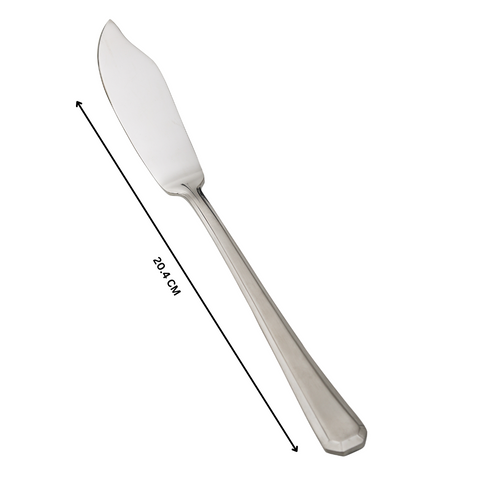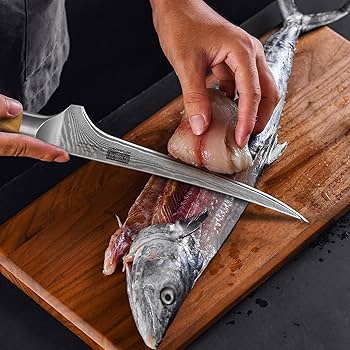How to select the best fish knife length for your needs
The Ultimate Overview to Preserving Your Fish Knife for Longevity and Performance
Preserving a fish knife is crucial for ensuring its long life and ideal performance. Proper treatment includes a series of steps, including cleansing, honing, and storage space. Each phase contributes to the knife's performance throughout usage. Comprehending these techniques can make a considerable difference in the life-span of this important device. However, several customers ignore important aspects of upkeep that can cause deterioration. What are these often-forgotten actions?
Picking the Right Fish Knife for Your Requirements
When selecting the perfect fish knife, what trick features should one think about? The blade's versatility is vital, enabling accuracy while filleting numerous fish varieties (fish knife). A slim, narrow blade commonly enhances maneuverability, making it simpler to browse around bones and skin. The product of the blade additionally plays a critical role; stainless-steel supplies durability and corrosion resistance, essential for constant exposure to water
Furthermore, the handle's style should not be ignored. It should give a comfy hold, ideally featuring non-slip products that make sure security throughout usage. The knife's length is an additional aspect; shorter blades can provide much better control, while longer blades may be helpful for bigger fish. Weight is crucial; a well-balanced knife permits for extended use without tiredness. By very carefully taking into consideration these attributes, one can pick a fish knife that meets particular requirements for efficient fish prep work.
Correct Cleaning Techniques After Each Usage
Proper cleaning techniques after each use are essential for keeping the longevity and performance of a fish knife. Instantly after filleting fish, it is essential to wash the knife under warm water to eliminate scales, slime, and any recurring fish juices. Using a soft sponge or fabric, the customer should carefully scrub the blade and deal with, paying special attention to any kind of gaps where debris may accumulate. Prevent utilizing abrasive products that might scratch the blade's surface area. After cleaning, the knife needs to be completely dried with a tidy towel to stop moisture-related damages. Using a food-safe mineral oil periodically can help preserve its honesty if the knife has a wooden handle. Storing the knife in a designated sheath or magnetic strip can even more safeguard it from unintended damage and guarantee it continues to be prepared and tidy for future use. Consistent adherence to these cleaning methods will boost the knife's life-span and effectiveness.
Developing Your Fish Knife: Devices and Techniques
Sharpening a fish knife is a crucial process that boosts its performance and guarantees clean cuts while filleting. To achieve optimal sharpness, several tools can be used. A whetstone is thought about among one of the most effective methods, enabling exact control over the sharpening angle. Users need to wet the stone and maintain a consistent 20-degree angle while moving the blade throughout its surface.
Additionally, a sharpening pole can be utilized for routine maintenance, realigning the blade's side without removing material. For benefit, electrical sharpeners provide a fast service, though they may not offer the same level of finesse as manual approaches.
No matter the chosen technique, it is important to completed with a leather strop to brighten the edge, making certain a sharp coating. Routine honing not only prolongs the life of the fish knife but also boosts the total efficiency of the filleting process.
Saving Your Fish Knife for Optimum Defense
After developing a fish knife, focus should transform to its storage to maintain the blade's integrity and efficiency. Appropriate storage is vital for protecting against damage, rust, and dulling. Ideally, a fish knife ought to be stored in a safety sheath or knife roll, which shields the blade from contact with other tools and environmental variables (fish knife). Magnetic strips can also be reliable, allowing for obtainable and secure storage space while keeping the blade secure

Routine Upkeep Regimens to Adhere To
A consistent upkeep regimen is essential for protecting the performance and appearance of a fish knife. Normal cleansing after each use is important; washing the blade with warm water and moderate soap removes any kind of residue. It is advisable to dry out the knife completely to stop corrosion. Occasionally, a light application of food-safe mineral oil can assist shield the blade and maintain its shine.

Storing the fish knife in a safety case or sheath avoids accidental damages and keeps it ready for usage. Complying with these maintenance regimens will dramatically improve the long life and efficiency of the fish knife.
Regularly Asked Concerns
Can I Use My Fish Knife for Various Other Types of Fish?
Yes, a fish knife can be utilized for various other sorts of fish. Nonetheless, the efficiency may vary depending upon the knife's design and the particular fish being processed, affecting effectiveness and accuracy during preparation.
What Materials Are Finest for a Fish Knife Blade?
Stainless-steel and high-carbon steel are thought about the very best products for a fish knife blade. Stainless steel uses corrosion resistance, while high-carbon steel gives premium intensity and side retention, crucial for reliable fish preparation.
Exactly how Usually Should I Change My Fish Knife?
A fish knife need to usually be replaced every three to 5 years, depending on use and upkeep. Routine evaluation for indications of wear or damages can additionally assist determine the correct time for replacement.
Are There Details Brands Known for Top Quality Fish Knives?
Certain brands, like Wüsthof, Victorinox, and Rapala, are renowned for producing high-quality fish blades. These brand names are recognized for their sturdiness, sharpness, and ergonomic styles, making them preferred selections among angling lovers and experts alike.
Can Temperature Affect My Fish Knife's Efficiency?
Temperature can dramatically affect a fish knife's performance. Severe warmth may cause blade products to warp, while chilly problems can bring about brittleness. Preserving an ideal temperature is important for preserving the knife's performance and longevity.
The knife's size is another element; much shorter blades can supply far better control, while longer blades may be helpful for bigger fish. Immediately after filleting fish, it is crucial to wash the knife under cozy water to remove scales, sludge, and any type of recurring fish juices. After developing a fish knife, interest has to transform to its storage space to keep the blade's integrity and efficiency. Ideally, a fish knife need to be kept in a protective sheath or knife roll, which shields the blade from call with ecological elements and other utensils. Yes, a fish knife can be utilized for click here various other kinds of fish.